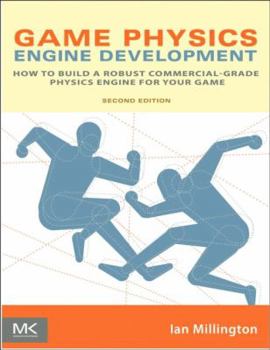Game Physics Engine Development (Series In Interactive 3D Technology)
Select Format
Select Condition 
Book Overview
Simulating physics helps cutting-edge games distinguish themselves by making virtual objects behave as we expect them to in the real world. Physics engines are the software programs that run these simulations. Building an engine is difficult, however. There are a large number of new developers (and hobbyists) coming into this market who need help through this complex process. Current introductory books are inadequate; they don't bring enough real-world programming experience to the task. There is a need for an introductory book on game physics with solid coding guidance but which limits the math content. Ian Millington brings his extensive professional programming experience to this problem. He has developed games since 1987, has studied AI and mathematics at the PhD level, and founded Mindlathe Ltd., a company that designed and built commercial physics engines. Physics Engine Development carefully describes each step in the creation of a robust, usable physics engine. It introduces the mathematical concepts in a clear and simple manner, keeping to high school level topics and building a physics code library as it goes. Each new concept is explained in diagrams and code to make sure that even the most novice of game programmers understands. The companion CD-ROM includes the source code for a complete physics engine of commercial quality. This book will serve as a introduction to more mathematically advanced books on game physics, such as Dave Eberly's Game Physics.
Format:Hardcover
Language:English
ISBN:012369471X
ISBN13:9780123694713
Release Date:March 2007
Publisher:CRC Press
Length:480 Pages
Weight:2.20 lbs.
Dimensions:9.8" x 1.3" x 8.0"
Customer Reviews
5 ratings
Excellent Book
Published by Thriftbooks.com User , 16 years ago
I've been trying to develop my own game physics engine for some time and I have tried with several books but this is the first one that helped me to start developing real engine. Other books are either too theoretical or implement each concept independently while engine requires concepts to be implemented in a generic way.
Good depth + good explanations = good book
Published by Thriftbooks.com User , 16 years ago
The author has obviously spent quite a large amount of time around physics and programming, and it really shows throughout the book that he has taken the time to make sure that he not only fully explains himself, but also make sure he has explained an appropriate amount of depth for the engineer who simply wants to make usage of the concepts. He does, however, make mention that he is primarily concerned with one particular kind of physics engine development (impulse based), and doesn't necessarily always makes full mention of alternative methods. He still does a decent job at explaining the core concepts along with increasing level of difficulty as the book progresses. For somebody who wants the most basic form of physics, this book is not suitable for that purpose: it is an intermediate level book. The first chapters start out at a very basic level (note: it is obvious to me that the other review by the guy from China saying this book is only beginner level material didn't bother reading beyond the first two chapters), but the rest of the book is clearly not beginner level material. However, this book is also not a substitute for a really advanced physics engine the likes of which Havoc and Ageia run off into. As well, the code implementations done by the author also reflect only an intermediate level of software engineering, but I admit that may just be an offshoot of simply trying to provide educational examples relative to the discussion. Overall though, a very good read. Make sure it fits your requirements first though.
A usefull book
Published by Thriftbooks.com User , 17 years ago
is a very best practical reference to development a physic game engine. Another books, too many mathematics, other, very simple, this it is a book halfway among mathematics and practical code.
Good principles and gives you a feel for the workings :)
Published by Thriftbooks.com User , 18 years ago
I found it a good read, and you can in most cases get a feel for what the writer is trying to achieve....he puts across the basic principle and then goes into a few ways of how you would compensate for such things, such as wobbling on the ground, multiple collisions etc. i.e. Introducing a few bodges etc to get a realistic look...rather than follow the maths to the letter. Its not what I'd call a basic book which usually cover a lot of spheres and single point collisions, but then its not as advanced as eberlys....its a good intermediate book...definetly worth a read if your new to physics. Happy coding =)
Awesome Book!
Published by Thriftbooks.com User , 18 years ago
The book gives you step by step code on how to create a simple physics engine.





